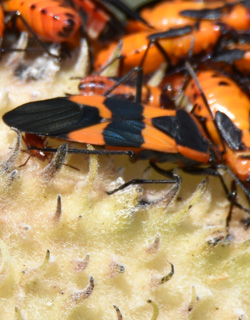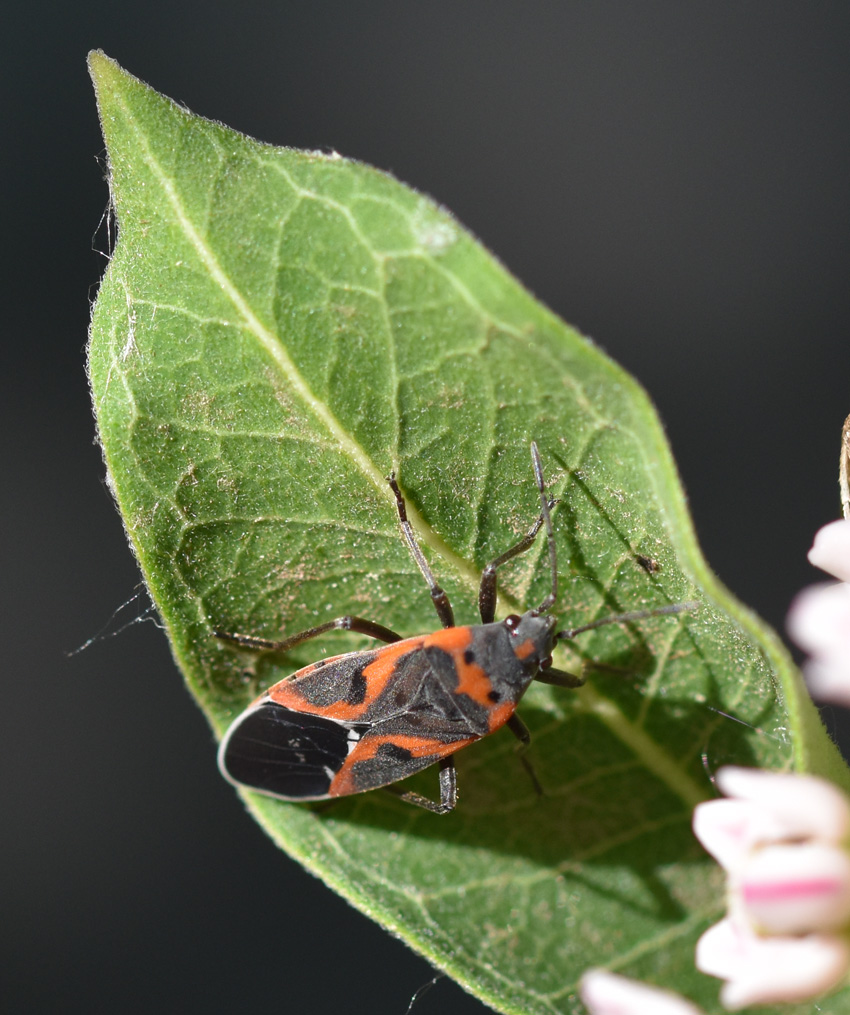This is another article on things that eat Milkweed. First I looked at two kinds of caterpillars, Monarch Butterfly caterpillars and Milkweed Tussock Moth caterpillars. Then I noticed and wrote up Red Milkweed Beetles. This time, though, I’ve been looking at another red and black insect on Milkweed that does not have small black dots but instead has large black hearts, bars and triangles. These are Milkweed Bugs.
If your red and black insect on a milkweed plant doesn’t look like these ones, you may want to check the article on Red Milkweed Beetles and on Box Elder Bugs.
What Is This (Gross ! ) Swarm of Red Insects Eating a Milkweed Seed Pod?
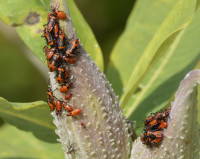
Is it just me, or do these look gross? (You can click to see a larger version, if you feel so inclined.)
Young Large Milkweed Bugs often feed together in a frankly rather revolting-looking mass. I’ve seen several clusters like this recently and I’ve been reluctant to photograph them even though it would be fairly easy to switch to my macro lens and get some good shots. I guess I shouldn’t be so squeamish. If they were something cute like a swarm of Eastern Tailed Blue butterflies puddling on the mud for a drink it wouldn’t bother me. I’m a “speciest” I guess.
Are These Small “Large” Milkweed Bugs or Large “Small” Milkweed Bugs?
There are two types of Milkweed Bugs: Large and Small.
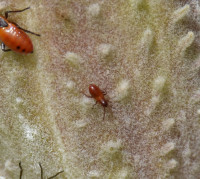
This is a very young Large Milkweed Bug.
According to BugGuide.net, young (nymphs) of the Large Milkweed Bug are more orange than red. To me they both look orange-red so that’s not much help.
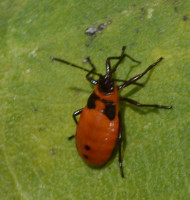
This is a very young Large Milkweed Bug.
The Large Milkweed Bug youngsters are also not supposed to have two black diagonal marks on the pronotum: that sounds like a more useful id clue–provided you know that the pronotum is the “neck-like” bit just behind the “face.”
So these are young Large Milkweed Bugs.
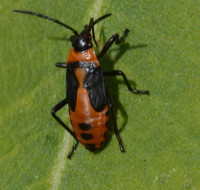
This is an older Large Milkweed Bug.
(Another possible clue is that it is more common for Large Milkweed Bugs to feed in these big groups on milkweed pods than it is for Small Milkweed Bugs.)
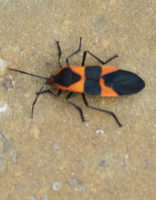
This is an adult Large Milkweed Bug.
If Milkweed Bugs Are Toxic to Predators Why Do They Swarm Together?
Many animals use a strategy for protection from predators where they move around in large groups. There are various opinions about how this offers protection but it does seem to benefit some species. Milkweed Bugs, however, are somewhat toxic to predators because of the chemicals they ingest when eating milkweed. So why do Large Milkweed Bugs stay together in a swarm instead of spreading out to other plants or at least other seed pods?
According to an article on the Riveredge Nature Center website one possible reason has to do with how these insects feed. Apparently, unlike Red Milkweed Beetles which chew the leaves and roots, Large Milkweed Bugs do not directly chew on the seed pods. Instead, they inject a chemical to break down the plant tissue with one tube-like part and use another tube to vacuum up the resulting juicy mess. Who knew? The article says that it’s possible that having a large group injecting the chemicals makes it easier for all to get a meal.
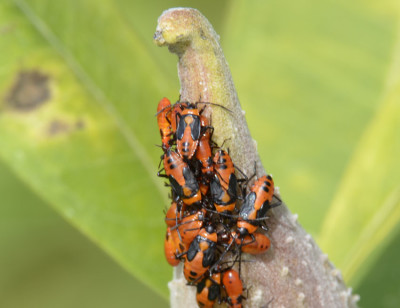
One article I skimmed mentioned that these bugs do best if they can get at the seeds through tender new skin on the pods. That might be why these ones have chosen to try to eat near the top of a pod.
Why Do These Milkweed Bugs Look Different from Each Other?
Milkweed Bugs have different marking at different ages but there are also two common types of Milkweed Bugs: Large and Small.
Some of the young or nymph stages of Small Milkweed Bugs have candy cane colouring: red and white stripes running from the head end to the tail end on the abdomen.
Adult Large Milkweed Bugs have a wide black stripe across their middle. The photo above is of a young almost adult Large Milkweed Bug.
Adult Small Milkweed Bugs don’t: they have a black heart shape on their back and two black triangles, one on either side, that don’t touch in the middle.
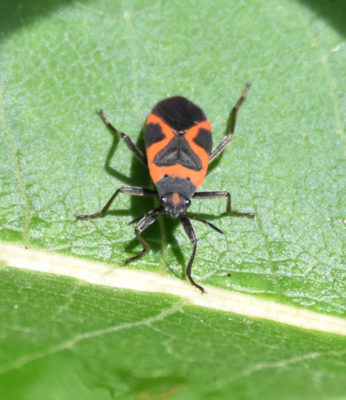
This is a fully grown Small Milkweed Bug.
It’s easiest to tell them apart by looking at photos of each type online on a site like BugGuide.net. I haven’t seen many Small Milkweed Bugs–yet!
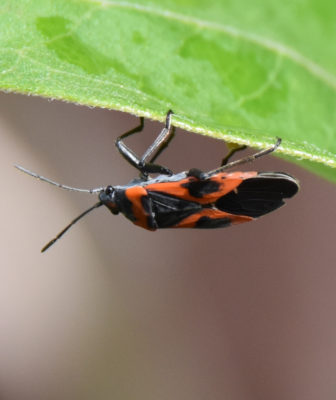
This Small Milkweed Bug was climbing along the edge and underside of a Common Milkweed leaf.
Do Large Milkweed Bugs Migrate?
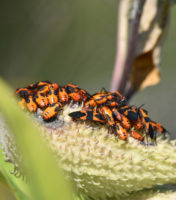
Again, click on the image only if you really want to see it enlarged.
I was surprised to read on BugGuide.net that Large Milkweed Bugs are not winter-tolerant. Instead, the ones we see in summer in Ontario have to arrive here as the dispersing offspring of ones that live further south year round. The article states that they also migrate south in the fall.
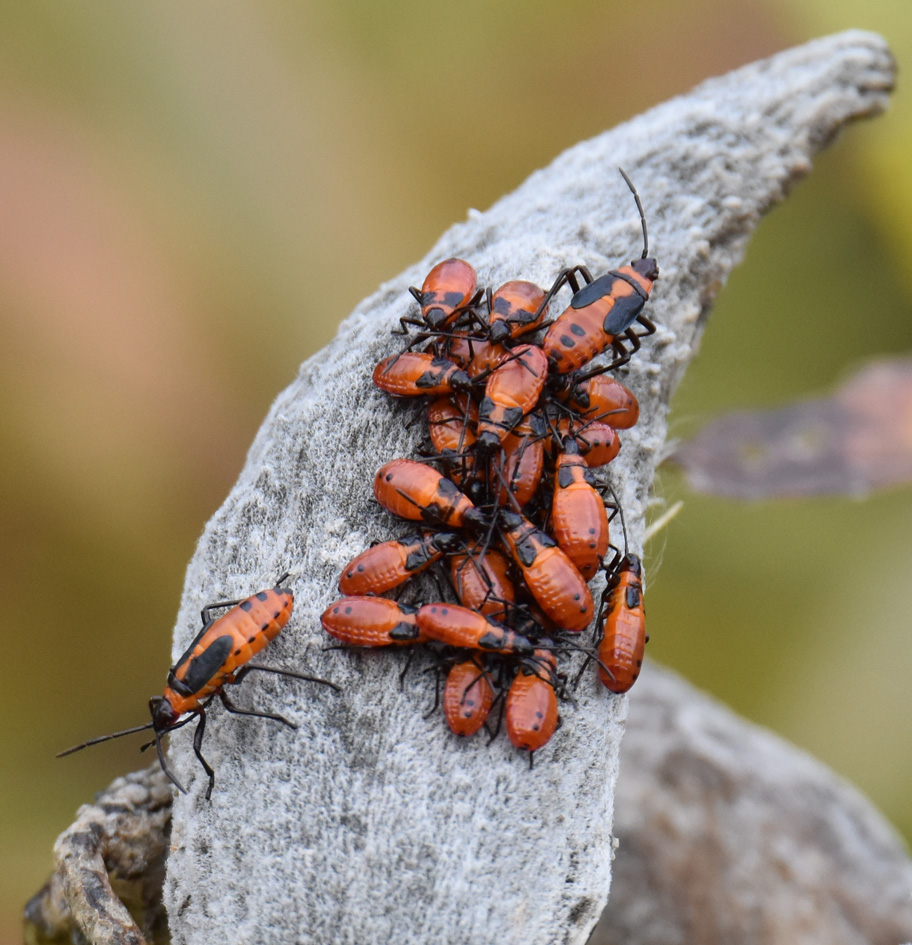
These guys better hurry up and grow up if they want to migrate. They were seen in early November.
I tried to find some further evidence that these bugs are migratory. I did find references in a few scientific papers to their migration but no details as it wasn’t the primary topic of the papers.
Related Reading
- Not Every Long-horned Beetle Is Endangering Our Forests
- Milkweed Predators: Milkweed Tussock Moth Caterpillars
- Milkweed Predators: Monarch Butterfly Caterpillars
- Milkweed Predators: Red Milkweed Beetles
Join In
Do swarms of Milkweed Bugs bother you? Please share your views with a comment.

